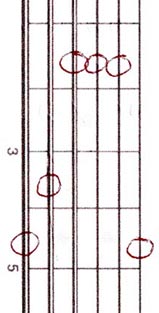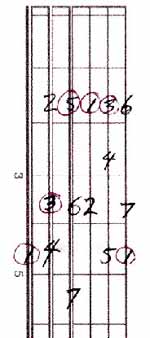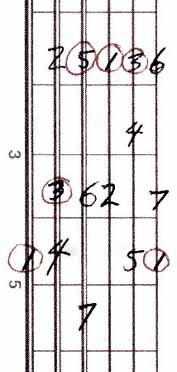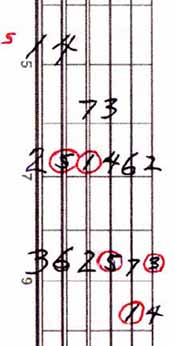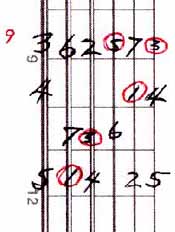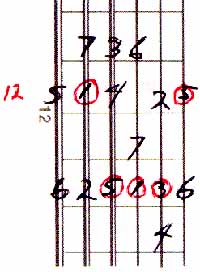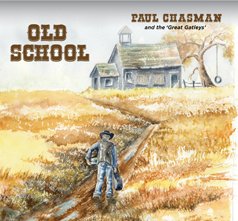CAGED Scales - April 1, 1999
 Before
I begin today, I want to briefly follow up my last column on
BALANCE. I recently talked with Salvatore Cosentino, who interviewed
Angelo Gilardino in the Guitar Review article I referred
to. He graciously assured me that it was not the publication's
viewpoint that "music is an end in itself." In fact,
he told me that the magazine quoted the above along with Mr.
Gilardino's statement, "If you create something, your life
will not need anything else..." in bold letters, not as
an endorsement of the view, but because because they found it
to be a provocative statement. Mr. Cosentino went on to say, "In
today's world, the likelihood of being able to devote one's complete
attention and energy exclusively toward any one thing is unrealistic,
especially for most young artists who must struggle to make a
living." He concluded by stating that neither he, nor Guitar
Review is "in a position to judge Mr. Gilardino's lifestyle
and approach, only the fact that this erudite composer, scholar
and historian has achieved great results that have benefited
the entire classical guitar community." Before
I begin today, I want to briefly follow up my last column on
BALANCE. I recently talked with Salvatore Cosentino, who interviewed
Angelo Gilardino in the Guitar Review article I referred
to. He graciously assured me that it was not the publication's
viewpoint that "music is an end in itself." In fact,
he told me that the magazine quoted the above along with Mr.
Gilardino's statement, "If you create something, your life
will not need anything else..." in bold letters, not as
an endorsement of the view, but because because they found it
to be a provocative statement. Mr. Cosentino went on to say, "In
today's world, the likelihood of being able to devote one's complete
attention and energy exclusively toward any one thing is unrealistic,
especially for most young artists who must struggle to make a
living." He concluded by stating that neither he, nor Guitar
Review is "in a position to judge Mr. Gilardino's lifestyle
and approach, only the fact that this erudite composer, scholar
and historian has achieved great results that have benefited
the entire classical guitar community."
OK. On with the column. Last month, I talked about the CAGED system of interlocking chord positions. Today, I want to talk about the integration of scales with these five chord shapes. A major scale is built on intervals of: whole step, whole step, half step, whole step, whole step, whole step, half step. For each position in the CAGED system, we will play a major scale in which every note in the chord position is contained in the scale. This is the key to seeing the integration between the two. Before we begin, just a couple of technical tips: 1) I will not discuss the fingering for each position, but as a rule, keep your fingers in a four fret span so that each finger takes a fret. If, as in the first scale I will show you, the span goes from the 2nd fret to the 5th fret, then your first finger covers whatever is in the 2nd fret, second finger takes the 3rd fret, third finger-4th fret, fourth finger-5th fret. If there is a note outside the four fret span, stretch for it rather that jump to it, which leads me to... 2) For your fingers to stay in a stretched out position, keep your thumb on an imaginary line in the middle of the neck. If your thumb is protruding, or if you're holding the neck like a club (which I do for other techniques), you will not be able to stretch as far. Also, the more you tilt the angle of the neck upwards, the farther you will be able to stretch. Let's cover the neck with A scales. We'll begin with A (G pos). The chord should look like this: Ex. #1 The scale should look like this: Ex. #2 Notice as I said before, every note in the chord is contained in the scale. Notice that every note in the chord is either a 1, 3, or 5. As you know, that is how a major chord is built. This is a clear example. Let's go on to A (E pos): Ex. #3 Although your barre is in the 5th fret when you play the chord, your first finger should be in the 4th fret when you play the scale, in order to give you the four fret span. Keep in mind that we are doing these scales in key of A, but we can do them in any key. The fingering for each position will be the same for any key; only the area of the neck will be different. For example, Bb (E pos) will be played with the same fingering as A (E pos), one fret higher. A (D pos) looks like this: Ex. #4 Start with your first finger in the 5th fret (two frets behind the barre), and stretch for the notes on the 6th & 5th strings. Then shift to the four fret span on the 4th & 3rd strings, and shift again to the new four fret span on the 2nd & 1st strings. Notice every two strings are the same fingering, and every two strings require a shift. The last two positions are the A (C pos) and A (A pos). Start both of these on the root (1), go as high as you can go in the position, work your way down below the root, and then walk back to the root, so that you are always starting and finishing on 1: Ex.#5 Ex.#6
So, now we have covered the neck with A scales. If you played them by this method, every note in every chord should be contained in the scale position you played. Notice that I designated the notes as 1,2,3,4,5, rather than A,B,C#,D,E. This makes the system universal. They are only A,B,C# in this one place on the neck, but they are 1,2,3 in any position. For this purpose, think: It's a 3rd, therefore it's a C#, rather than it's a C#, therefore it's a 3rd. It's only a C# in key of A. It's a 3rd in any position. Also, unless you are one of those rare people with perfect pitch, C# means nothing to your ear. But you can learn to hear a 3rd interval. So, in putting your priority on learning the relationship rather than the actual note, you can begin to train your ear to hear different intervals. With this in mind, here are a couple tips for practicing these scales: 1) Walk up the scale adding one note at a time. Walk up 1-2-3-2-1. Then, 1-2-3-4-3-2-1. Then, 1-2-3-4-5-4-3-2-1, etc. Each time you add a new note, say the note you are adding on to yourself. In this way, you will imprint that note and learn to hear it's relationship to the whole. 2) Stop on each root and play that root in the chord. Then do the same with the 3rds, then with the 5ths. This will help you to see the integration of the chord and scale. You want to get to the point where when you play the scale you can visualize the chord; when you play the chord you can visualize the scale. 3) Learn one position at a time. I've laid out all five positions for you so you can see the big picture, but I would advise against trying to learn all five of them at once. Keep in mind that the idea here is not just to be able to run up these scales as fast as you can. The conceptual part and the ear training are equally important. Don't just play the scales; learn them. Have fun. (April 1, 1999) BACK TO ARCHIVES |

